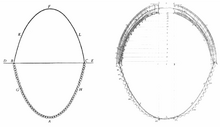
Back Seileckverfahren German Polígono funicular Spanish Méthode du dynamique et du funiculaire French

In architecture, the funicular curve (also funicular polygon, funicular shape, from the Latin: fūniculus, "of rope"[1]) is an approach used to design the compression-only structural forms (like masonry arches) using an equivalence between the rope with hanging weights and standing arch with its load. This duality was noticed by Robert Hooke in 1675 ("as hangs the flexible line, so, but inverted, will stand the rigid arch").[2] If the hanging rope carries just its own weight (in this case it is usually called a "chain" and is equivalent to a free-standing arch with no external load), the resulting curve is a catenary.[3]
In graphic statics, a funicular polygon is a graphic method of finding out the line of action for a combination of forces applied to a solid body at different points, a complement to the force polygon used to obtain the value and direction of the resultant force.[4] Both polygons were introduced by Pierre Varignon (Nouvelle Mecanique ou Statique, 1725) and became the basis of the graphic statics in the second half of the 19th century.[5]
- ^ Oxford University Press 1996, funicular.
- ^ Woodman & Heyman 2003, The voussoir arch.
- ^ Tomlow 2011, p. 219.
- ^ Escudier & Atkins 2019, funicular polygon.
- ^ Markou & Ruan 2022, p. 1390.